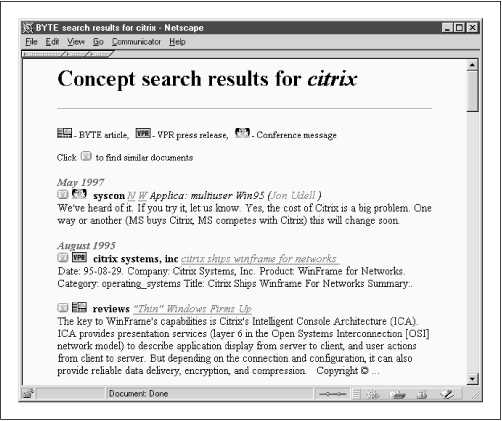Exploiting URL Namespaces and Doctitle Namespaces
We’ve seen how a docbase’s URL namespace can encode a lot
of information that can enable both programs and people to categorize
the subsets of that namespace that search engines return.
There’s also a complementary namespace that can carry an
additional information load. The <TITLE> tag
enclosed by an HTML document’s <HEAD>
is an invaluable but often underutilized resource. Text placed there
doesn’t appear in a web page. It becomes the title of the
window in which the browser displays the page. As I mentioned in
Chapter 5, you may be disappointed if you rely on
the window title to display information that is essential to users.
I’ve found that people don’t regard the window title as
part of a web page, so you have to recapitulate it in the body of web
pages in order to get people to notice it. But while this
doctitle namespace may not be very interesting
to people, it’s enormously useful to search-results scripts.
Figure 8.2 shows what a search-results page looked
like on the BYTE site.

Figure 8-2. Multidocbase search results
The result set draws from three different docbases, but everything fits into a common abstract pattern:
DATE TYPE SUBTYPE TITLE ABSTRACT
When you control both the search engine and the docbase, you can always achieve this effect. The question is: With how much effort? Careful design of the URL and doctitle ...
Get Practical Internet Groupware now with the O’Reilly learning platform.
O’Reilly members experience books, live events, courses curated by job role, and more from O’Reilly and nearly 200 top publishers.

